ACCT20074: Evaluation of Conceptual Framework and Reporting Practices
VerifiedAdded on 2022/11/11
|22
|5033
|488
Report
AI Summary
This report provides a comprehensive analysis of the conceptual framework (CF) for financial reporting and its application in sustainable reporting. It begins with an examination of the history, development, benefits, and limitations of the CF, followed by an evaluation of its application within Austal Limited. The report then explores the differences between the Global Reporting Initiative (GRI) and integrated reporting, and the theories that underpin sustainability reporting content. The report also provides a discussion of the various components of integrated reports in the context of Sibanye Gold Ltd. The report covers the history and development of the CF, concerns of Australian professionals, potential benefits and limitations, and the application of the CF to evaluate the annual report of Austal Limited. Additionally, the report compares GRI and integrated reporting and their application to a South African company, Sibanye Gold Ltd, and compares reporting practices between Australian and South African companies.
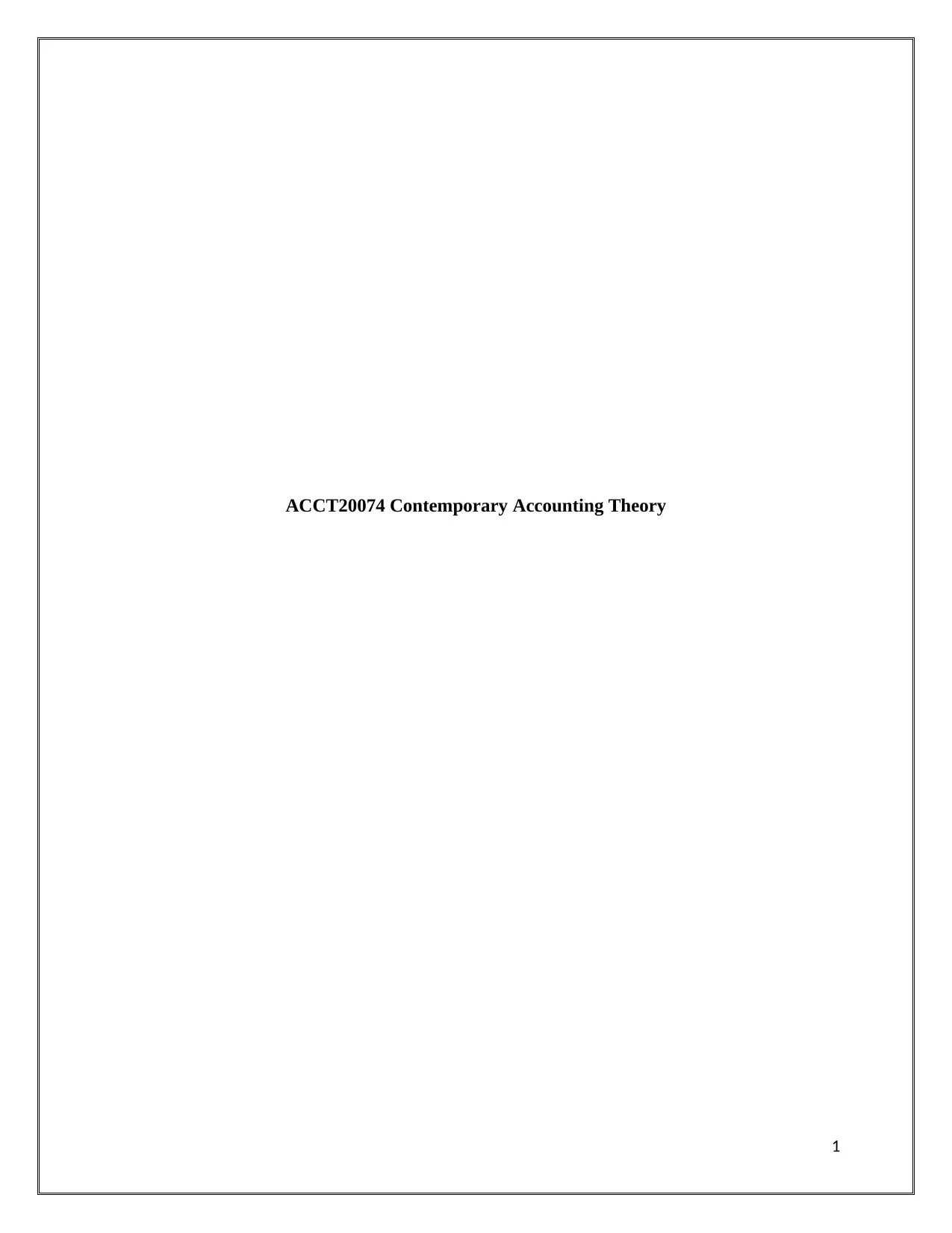
ACCT20074 Contemporary Accounting Theory
1
1
Paraphrase This Document
Need a fresh take? Get an instant paraphrase of this document with our AI Paraphraser
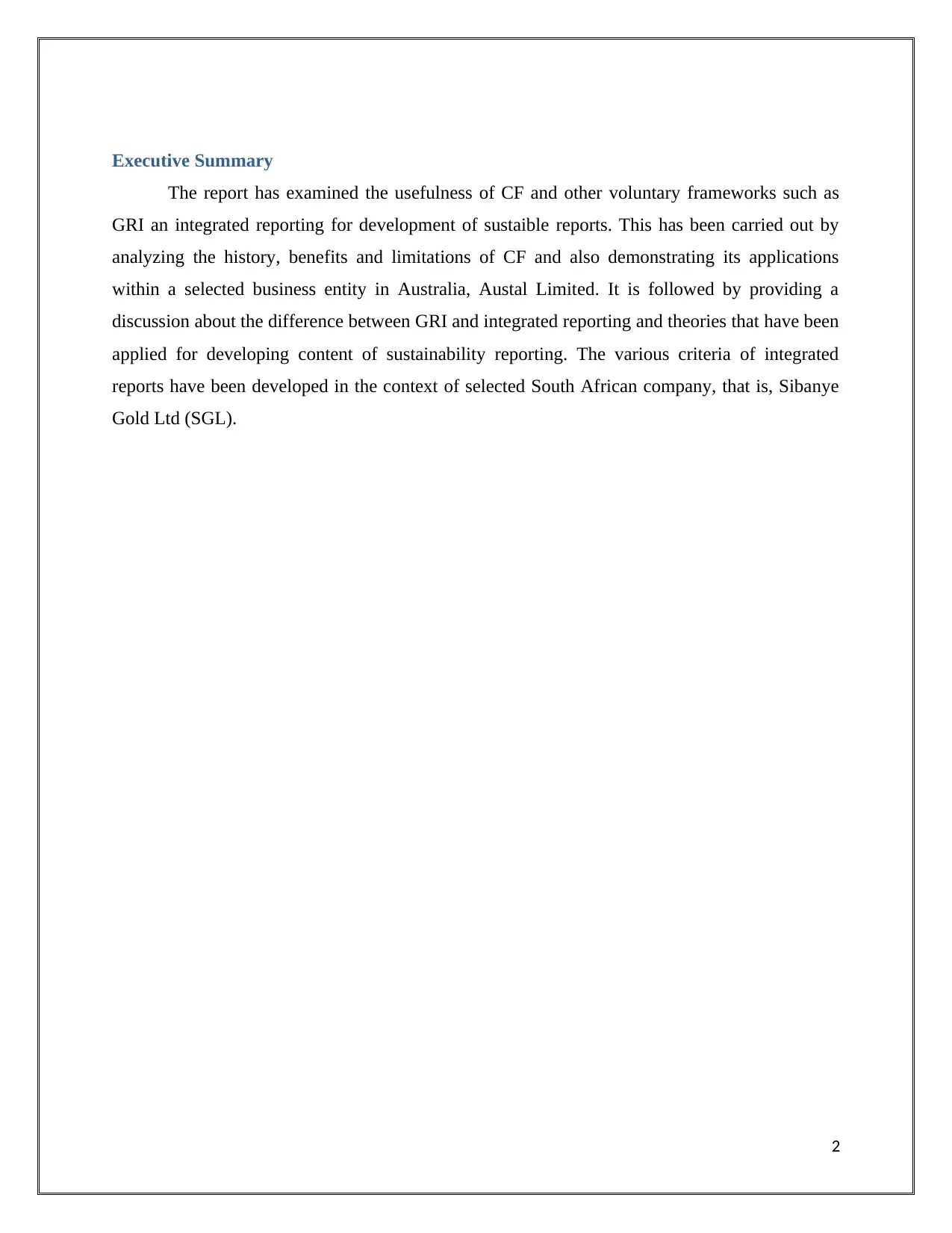
Executive Summary
The report has examined the usefulness of CF and other voluntary frameworks such as
GRI an integrated reporting for development of sustaible reports. This has been carried out by
analyzing the history, benefits and limitations of CF and also demonstrating its applications
within a selected business entity in Australia, Austal Limited. It is followed by providing a
discussion about the difference between GRI and integrated reporting and theories that have been
applied for developing content of sustainability reporting. The various criteria of integrated
reports have been developed in the context of selected South African company, that is, Sibanye
Gold Ltd (SGL).
2
The report has examined the usefulness of CF and other voluntary frameworks such as
GRI an integrated reporting for development of sustaible reports. This has been carried out by
analyzing the history, benefits and limitations of CF and also demonstrating its applications
within a selected business entity in Australia, Austal Limited. It is followed by providing a
discussion about the difference between GRI and integrated reporting and theories that have been
applied for developing content of sustainability reporting. The various criteria of integrated
reports have been developed in the context of selected South African company, that is, Sibanye
Gold Ltd (SGL).
2
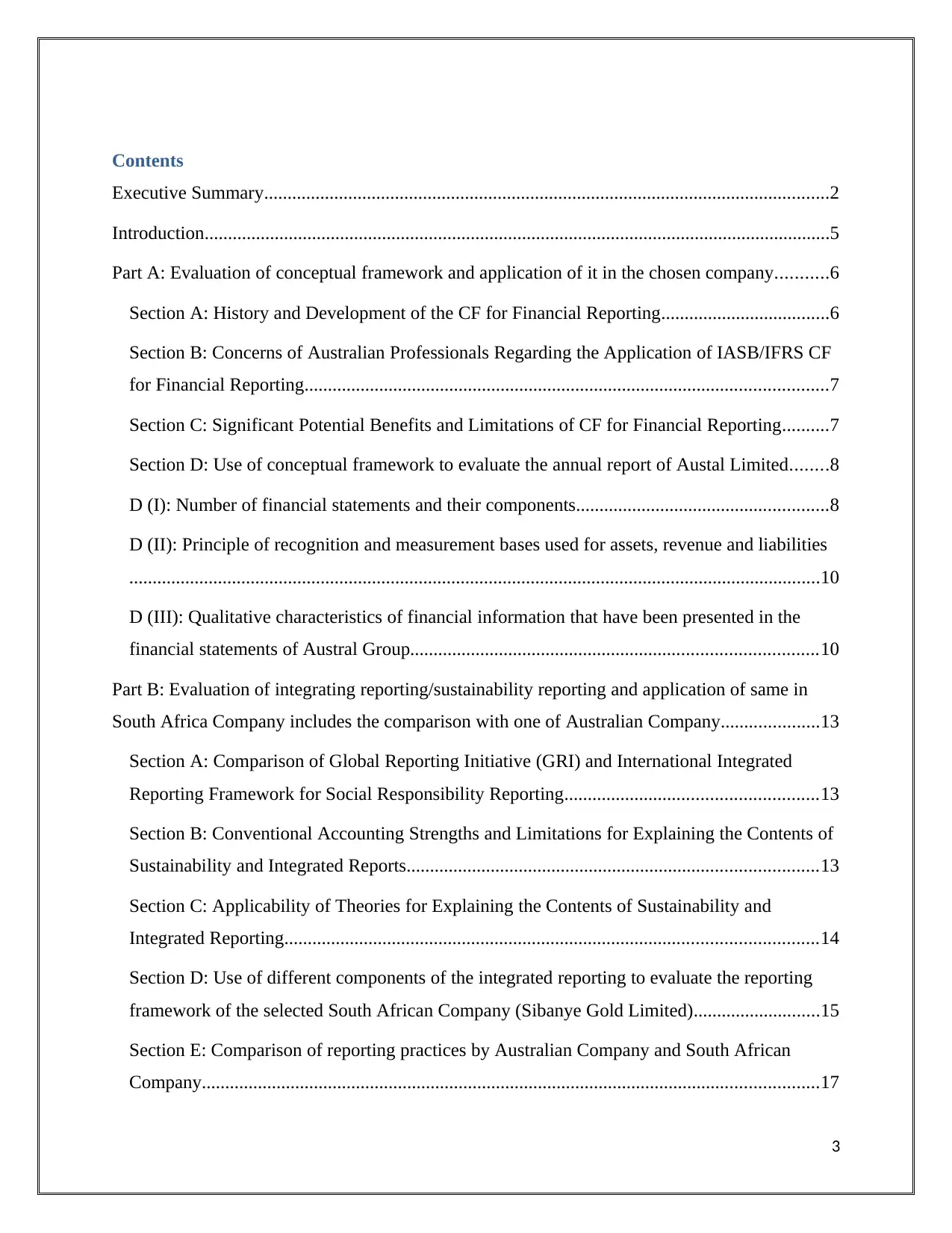
Contents
Executive Summary.........................................................................................................................2
Introduction......................................................................................................................................5
Part A: Evaluation of conceptual framework and application of it in the chosen company...........6
Section A: History and Development of the CF for Financial Reporting....................................6
Section B: Concerns of Australian Professionals Regarding the Application of IASB/IFRS CF
for Financial Reporting................................................................................................................7
Section C: Significant Potential Benefits and Limitations of CF for Financial Reporting..........7
Section D: Use of conceptual framework to evaluate the annual report of Austal Limited........8
D (I): Number of financial statements and their components......................................................8
D (II): Principle of recognition and measurement bases used for assets, revenue and liabilities
....................................................................................................................................................10
D (III): Qualitative characteristics of financial information that have been presented in the
financial statements of Austral Group.......................................................................................10
Part B: Evaluation of integrating reporting/sustainability reporting and application of same in
South Africa Company includes the comparison with one of Australian Company.....................13
Section A: Comparison of Global Reporting Initiative (GRI) and International Integrated
Reporting Framework for Social Responsibility Reporting......................................................13
Section B: Conventional Accounting Strengths and Limitations for Explaining the Contents of
Sustainability and Integrated Reports........................................................................................13
Section C: Applicability of Theories for Explaining the Contents of Sustainability and
Integrated Reporting..................................................................................................................14
Section D: Use of different components of the integrated reporting to evaluate the reporting
framework of the selected South African Company (Sibanye Gold Limited)...........................15
Section E: Comparison of reporting practices by Australian Company and South African
Company....................................................................................................................................17
3
Executive Summary.........................................................................................................................2
Introduction......................................................................................................................................5
Part A: Evaluation of conceptual framework and application of it in the chosen company...........6
Section A: History and Development of the CF for Financial Reporting....................................6
Section B: Concerns of Australian Professionals Regarding the Application of IASB/IFRS CF
for Financial Reporting................................................................................................................7
Section C: Significant Potential Benefits and Limitations of CF for Financial Reporting..........7
Section D: Use of conceptual framework to evaluate the annual report of Austal Limited........8
D (I): Number of financial statements and their components......................................................8
D (II): Principle of recognition and measurement bases used for assets, revenue and liabilities
....................................................................................................................................................10
D (III): Qualitative characteristics of financial information that have been presented in the
financial statements of Austral Group.......................................................................................10
Part B: Evaluation of integrating reporting/sustainability reporting and application of same in
South Africa Company includes the comparison with one of Australian Company.....................13
Section A: Comparison of Global Reporting Initiative (GRI) and International Integrated
Reporting Framework for Social Responsibility Reporting......................................................13
Section B: Conventional Accounting Strengths and Limitations for Explaining the Contents of
Sustainability and Integrated Reports........................................................................................13
Section C: Applicability of Theories for Explaining the Contents of Sustainability and
Integrated Reporting..................................................................................................................14
Section D: Use of different components of the integrated reporting to evaluate the reporting
framework of the selected South African Company (Sibanye Gold Limited)...........................15
Section E: Comparison of reporting practices by Australian Company and South African
Company....................................................................................................................................17
3
⊘ This is a preview!⊘
Do you want full access?
Subscribe today to unlock all pages.

Trusted by 1+ million students worldwide
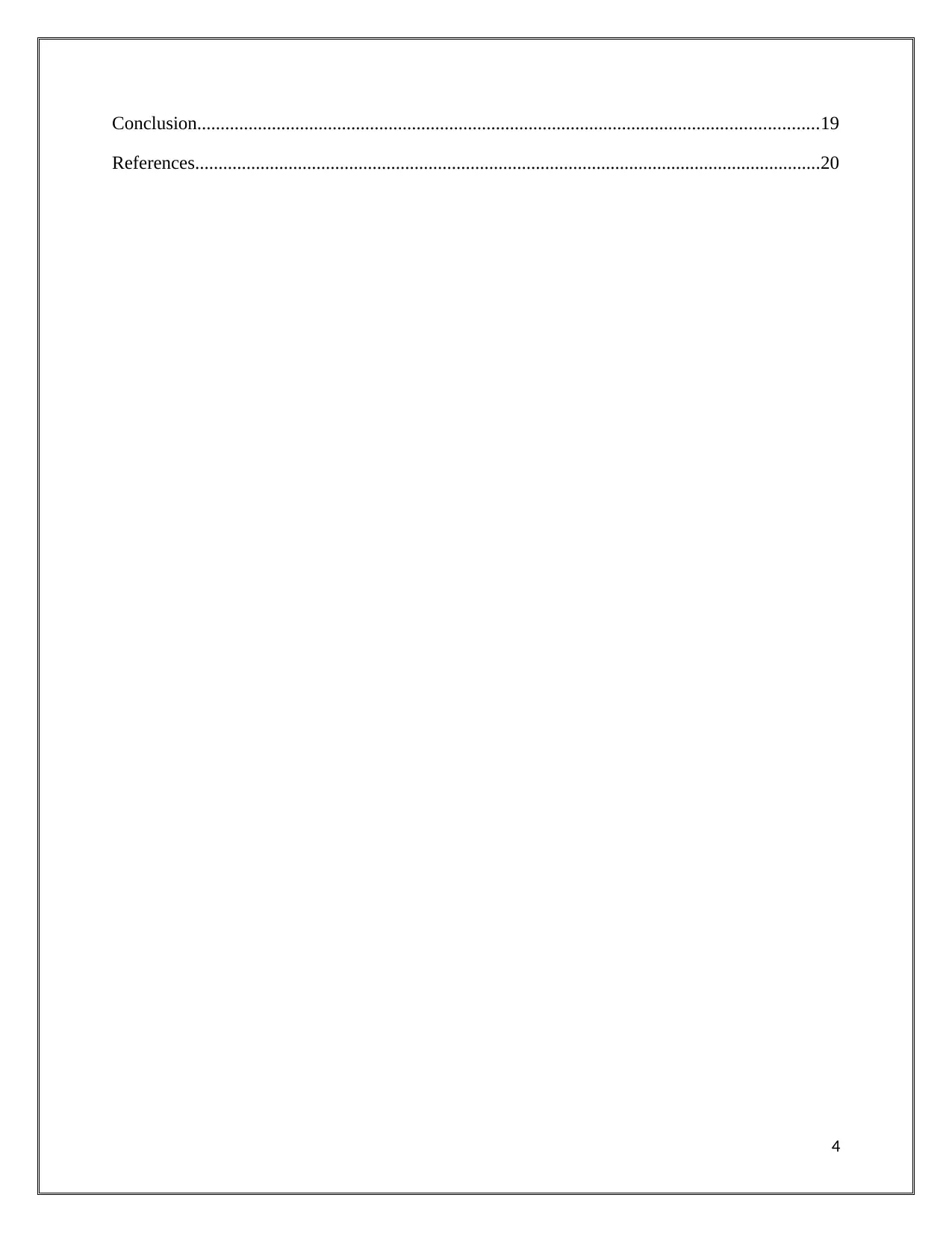
Conclusion.....................................................................................................................................19
References......................................................................................................................................20
4
References......................................................................................................................................20
4
Paraphrase This Document
Need a fresh take? Get an instant paraphrase of this document with our AI Paraphraser
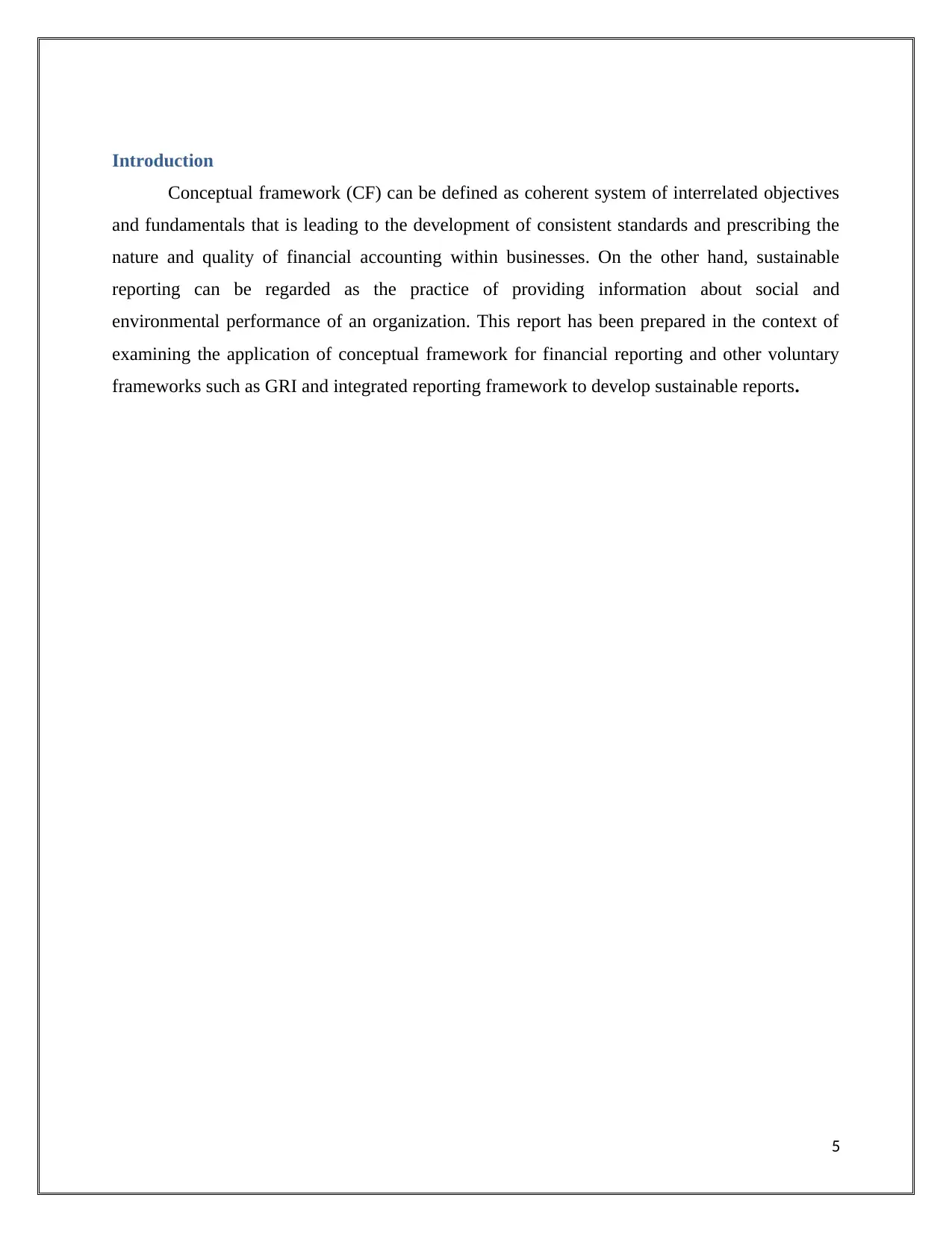
Introduction
Conceptual framework (CF) can be defined as coherent system of interrelated objectives
and fundamentals that is leading to the development of consistent standards and prescribing the
nature and quality of financial accounting within businesses. On the other hand, sustainable
reporting can be regarded as the practice of providing information about social and
environmental performance of an organization. This report has been prepared in the context of
examining the application of conceptual framework for financial reporting and other voluntary
frameworks such as GRI and integrated reporting framework to develop sustainable reports.
5
Conceptual framework (CF) can be defined as coherent system of interrelated objectives
and fundamentals that is leading to the development of consistent standards and prescribing the
nature and quality of financial accounting within businesses. On the other hand, sustainable
reporting can be regarded as the practice of providing information about social and
environmental performance of an organization. This report has been prepared in the context of
examining the application of conceptual framework for financial reporting and other voluntary
frameworks such as GRI and integrated reporting framework to develop sustainable reports.
5
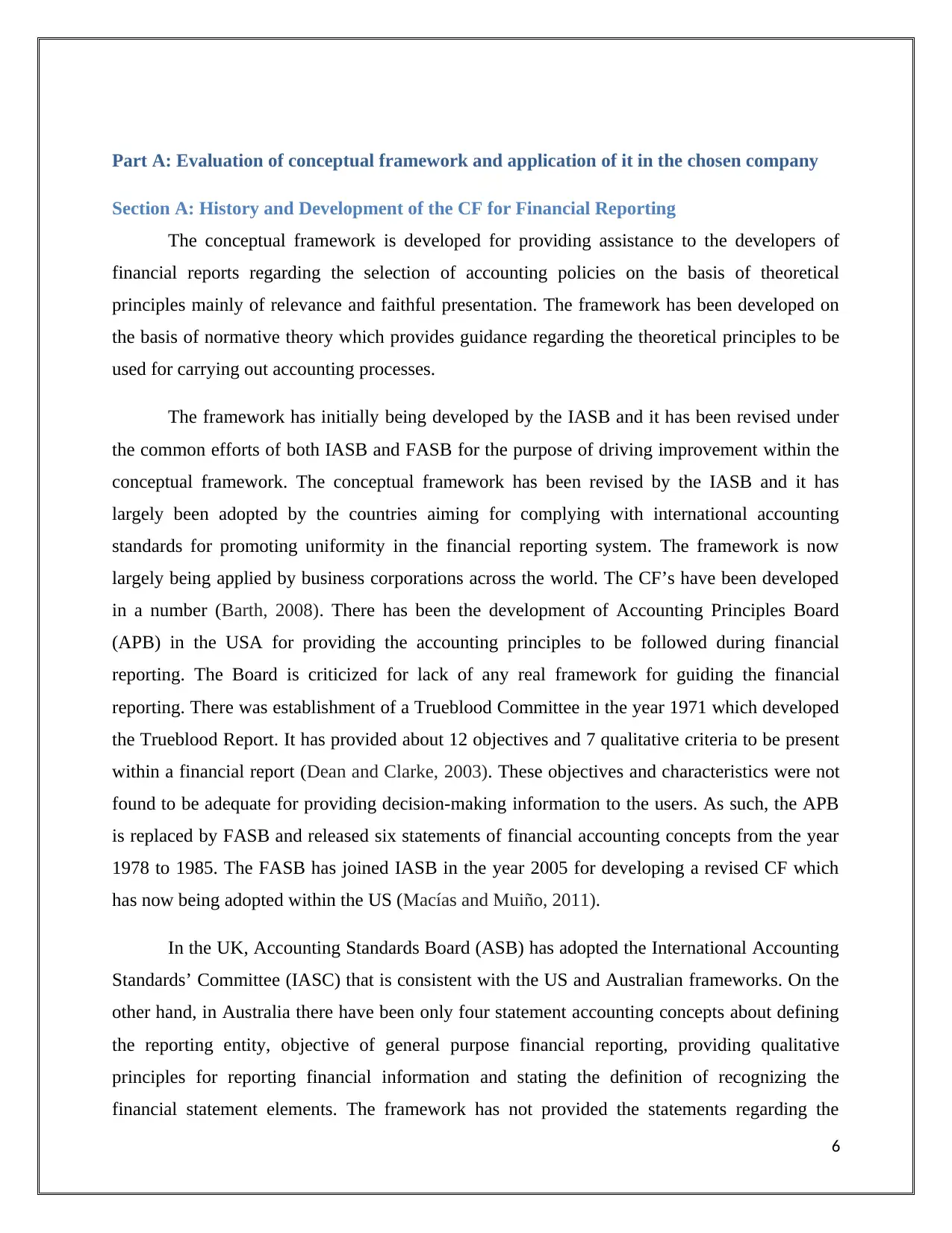
Part A: Evaluation of conceptual framework and application of it in the chosen company
Section A: History and Development of the CF for Financial Reporting
The conceptual framework is developed for providing assistance to the developers of
financial reports regarding the selection of accounting policies on the basis of theoretical
principles mainly of relevance and faithful presentation. The framework has been developed on
the basis of normative theory which provides guidance regarding the theoretical principles to be
used for carrying out accounting processes.
The framework has initially being developed by the IASB and it has been revised under
the common efforts of both IASB and FASB for the purpose of driving improvement within the
conceptual framework. The conceptual framework has been revised by the IASB and it has
largely been adopted by the countries aiming for complying with international accounting
standards for promoting uniformity in the financial reporting system. The framework is now
largely being applied by business corporations across the world. The CF’s have been developed
in a number (Barth, 2008). There has been the development of Accounting Principles Board
(APB) in the USA for providing the accounting principles to be followed during financial
reporting. The Board is criticized for lack of any real framework for guiding the financial
reporting. There was establishment of a Trueblood Committee in the year 1971 which developed
the Trueblood Report. It has provided about 12 objectives and 7 qualitative criteria to be present
within a financial report (Dean and Clarke, 2003). These objectives and characteristics were not
found to be adequate for providing decision-making information to the users. As such, the APB
is replaced by FASB and released six statements of financial accounting concepts from the year
1978 to 1985. The FASB has joined IASB in the year 2005 for developing a revised CF which
has now being adopted within the US (Macías and Muiño, 2011).
In the UK, Accounting Standards Board (ASB) has adopted the International Accounting
Standards’ Committee (IASC) that is consistent with the US and Australian frameworks. On the
other hand, in Australia there have been only four statement accounting concepts about defining
the reporting entity, objective of general purpose financial reporting, providing qualitative
principles for reporting financial information and stating the definition of recognizing the
financial statement elements. The framework has not provided the statements regarding the
6
Section A: History and Development of the CF for Financial Reporting
The conceptual framework is developed for providing assistance to the developers of
financial reports regarding the selection of accounting policies on the basis of theoretical
principles mainly of relevance and faithful presentation. The framework has been developed on
the basis of normative theory which provides guidance regarding the theoretical principles to be
used for carrying out accounting processes.
The framework has initially being developed by the IASB and it has been revised under
the common efforts of both IASB and FASB for the purpose of driving improvement within the
conceptual framework. The conceptual framework has been revised by the IASB and it has
largely been adopted by the countries aiming for complying with international accounting
standards for promoting uniformity in the financial reporting system. The framework is now
largely being applied by business corporations across the world. The CF’s have been developed
in a number (Barth, 2008). There has been the development of Accounting Principles Board
(APB) in the USA for providing the accounting principles to be followed during financial
reporting. The Board is criticized for lack of any real framework for guiding the financial
reporting. There was establishment of a Trueblood Committee in the year 1971 which developed
the Trueblood Report. It has provided about 12 objectives and 7 qualitative criteria to be present
within a financial report (Dean and Clarke, 2003). These objectives and characteristics were not
found to be adequate for providing decision-making information to the users. As such, the APB
is replaced by FASB and released six statements of financial accounting concepts from the year
1978 to 1985. The FASB has joined IASB in the year 2005 for developing a revised CF which
has now being adopted within the US (Macías and Muiño, 2011).
In the UK, Accounting Standards Board (ASB) has adopted the International Accounting
Standards’ Committee (IASC) that is consistent with the US and Australian frameworks. On the
other hand, in Australia there have been only four statement accounting concepts about defining
the reporting entity, objective of general purpose financial reporting, providing qualitative
principles for reporting financial information and stating the definition of recognizing the
financial statement elements. The framework has not provided the statements regarding the
6
⊘ This is a preview!⊘
Do you want full access?
Subscribe today to unlock all pages.

Trusted by 1+ million students worldwide
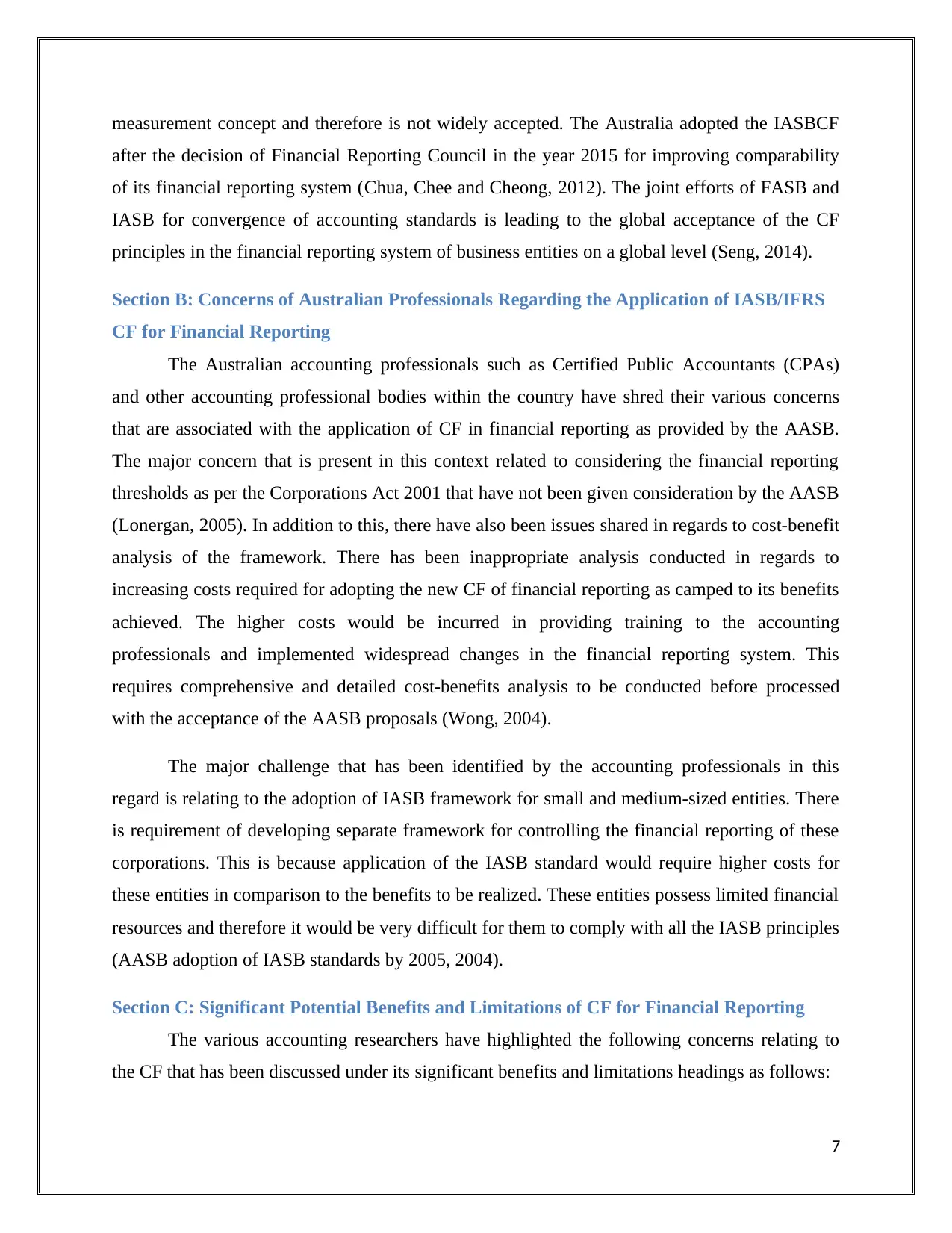
measurement concept and therefore is not widely accepted. The Australia adopted the IASBCF
after the decision of Financial Reporting Council in the year 2015 for improving comparability
of its financial reporting system (Chua, Chee and Cheong, 2012). The joint efforts of FASB and
IASB for convergence of accounting standards is leading to the global acceptance of the CF
principles in the financial reporting system of business entities on a global level (Seng, 2014).
Section B: Concerns of Australian Professionals Regarding the Application of IASB/IFRS
CF for Financial Reporting
The Australian accounting professionals such as Certified Public Accountants (CPAs)
and other accounting professional bodies within the country have shred their various concerns
that are associated with the application of CF in financial reporting as provided by the AASB.
The major concern that is present in this context related to considering the financial reporting
thresholds as per the Corporations Act 2001 that have not been given consideration by the AASB
(Lonergan, 2005). In addition to this, there have also been issues shared in regards to cost-benefit
analysis of the framework. There has been inappropriate analysis conducted in regards to
increasing costs required for adopting the new CF of financial reporting as camped to its benefits
achieved. The higher costs would be incurred in providing training to the accounting
professionals and implemented widespread changes in the financial reporting system. This
requires comprehensive and detailed cost-benefits analysis to be conducted before processed
with the acceptance of the AASB proposals (Wong, 2004).
The major challenge that has been identified by the accounting professionals in this
regard is relating to the adoption of IASB framework for small and medium-sized entities. There
is requirement of developing separate framework for controlling the financial reporting of these
corporations. This is because application of the IASB standard would require higher costs for
these entities in comparison to the benefits to be realized. These entities possess limited financial
resources and therefore it would be very difficult for them to comply with all the IASB principles
(AASB adoption of IASB standards by 2005, 2004).
Section C: Significant Potential Benefits and Limitations of CF for Financial Reporting
The various accounting researchers have highlighted the following concerns relating to
the CF that has been discussed under its significant benefits and limitations headings as follows:
7
after the decision of Financial Reporting Council in the year 2015 for improving comparability
of its financial reporting system (Chua, Chee and Cheong, 2012). The joint efforts of FASB and
IASB for convergence of accounting standards is leading to the global acceptance of the CF
principles in the financial reporting system of business entities on a global level (Seng, 2014).
Section B: Concerns of Australian Professionals Regarding the Application of IASB/IFRS
CF for Financial Reporting
The Australian accounting professionals such as Certified Public Accountants (CPAs)
and other accounting professional bodies within the country have shred their various concerns
that are associated with the application of CF in financial reporting as provided by the AASB.
The major concern that is present in this context related to considering the financial reporting
thresholds as per the Corporations Act 2001 that have not been given consideration by the AASB
(Lonergan, 2005). In addition to this, there have also been issues shared in regards to cost-benefit
analysis of the framework. There has been inappropriate analysis conducted in regards to
increasing costs required for adopting the new CF of financial reporting as camped to its benefits
achieved. The higher costs would be incurred in providing training to the accounting
professionals and implemented widespread changes in the financial reporting system. This
requires comprehensive and detailed cost-benefits analysis to be conducted before processed
with the acceptance of the AASB proposals (Wong, 2004).
The major challenge that has been identified by the accounting professionals in this
regard is relating to the adoption of IASB framework for small and medium-sized entities. There
is requirement of developing separate framework for controlling the financial reporting of these
corporations. This is because application of the IASB standard would require higher costs for
these entities in comparison to the benefits to be realized. These entities possess limited financial
resources and therefore it would be very difficult for them to comply with all the IASB principles
(AASB adoption of IASB standards by 2005, 2004).
Section C: Significant Potential Benefits and Limitations of CF for Financial Reporting
The various accounting researchers have highlighted the following concerns relating to
the CF that has been discussed under its significant benefits and limitations headings as follows:
7
Paraphrase This Document
Need a fresh take? Get an instant paraphrase of this document with our AI Paraphraser
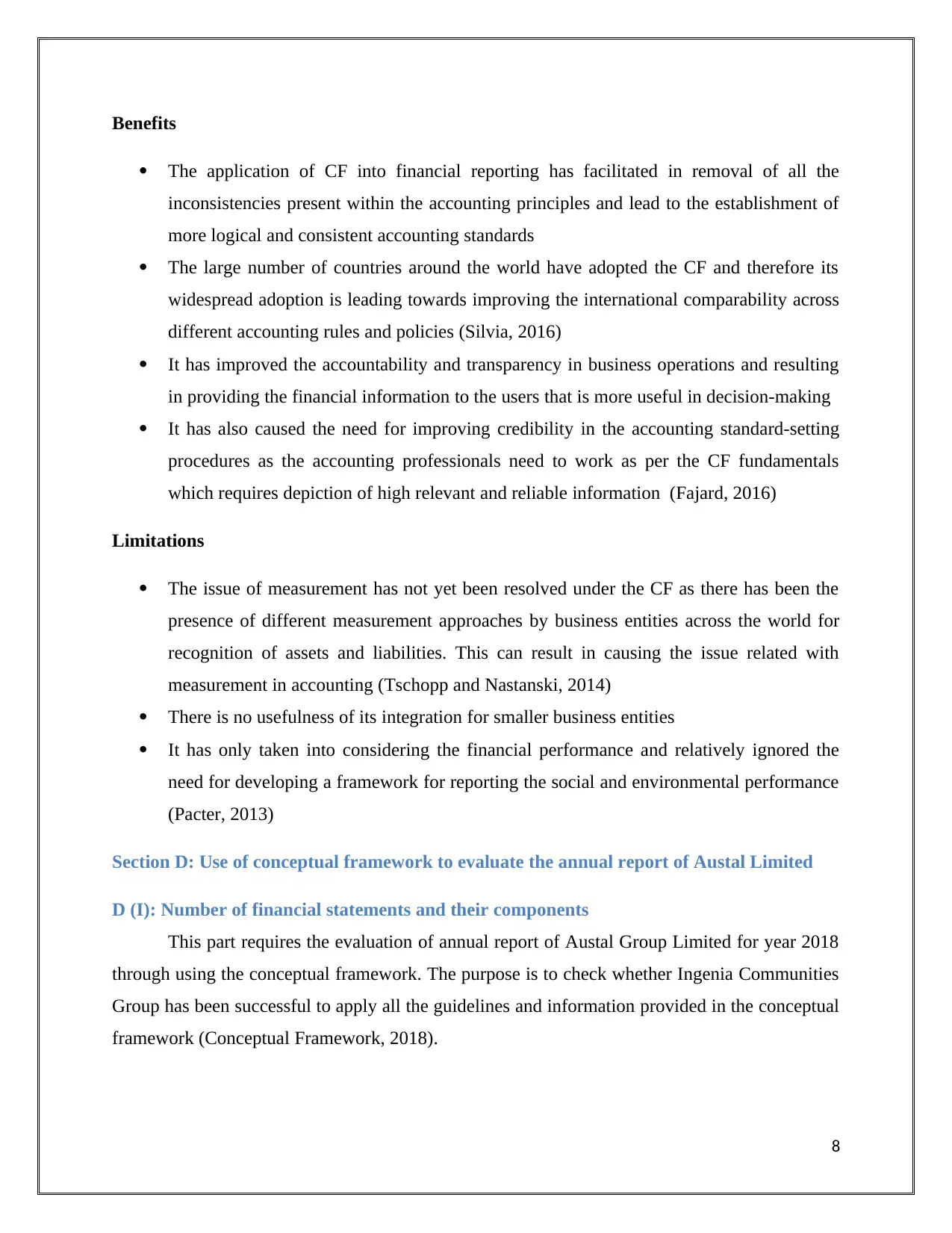
Benefits
The application of CF into financial reporting has facilitated in removal of all the
inconsistencies present within the accounting principles and lead to the establishment of
more logical and consistent accounting standards
The large number of countries around the world have adopted the CF and therefore its
widespread adoption is leading towards improving the international comparability across
different accounting rules and policies (Silvia, 2016)
It has improved the accountability and transparency in business operations and resulting
in providing the financial information to the users that is more useful in decision-making
It has also caused the need for improving credibility in the accounting standard-setting
procedures as the accounting professionals need to work as per the CF fundamentals
which requires depiction of high relevant and reliable information (Fajard, 2016)
Limitations
The issue of measurement has not yet been resolved under the CF as there has been the
presence of different measurement approaches by business entities across the world for
recognition of assets and liabilities. This can result in causing the issue related with
measurement in accounting (Tschopp and Nastanski, 2014)
There is no usefulness of its integration for smaller business entities
It has only taken into considering the financial performance and relatively ignored the
need for developing a framework for reporting the social and environmental performance
(Pacter, 2013)
Section D: Use of conceptual framework to evaluate the annual report of Austal Limited
D (I): Number of financial statements and their components
This part requires the evaluation of annual report of Austal Group Limited for year 2018
through using the conceptual framework. The purpose is to check whether Ingenia Communities
Group has been successful to apply all the guidelines and information provided in the conceptual
framework (Conceptual Framework, 2018).
8
The application of CF into financial reporting has facilitated in removal of all the
inconsistencies present within the accounting principles and lead to the establishment of
more logical and consistent accounting standards
The large number of countries around the world have adopted the CF and therefore its
widespread adoption is leading towards improving the international comparability across
different accounting rules and policies (Silvia, 2016)
It has improved the accountability and transparency in business operations and resulting
in providing the financial information to the users that is more useful in decision-making
It has also caused the need for improving credibility in the accounting standard-setting
procedures as the accounting professionals need to work as per the CF fundamentals
which requires depiction of high relevant and reliable information (Fajard, 2016)
Limitations
The issue of measurement has not yet been resolved under the CF as there has been the
presence of different measurement approaches by business entities across the world for
recognition of assets and liabilities. This can result in causing the issue related with
measurement in accounting (Tschopp and Nastanski, 2014)
There is no usefulness of its integration for smaller business entities
It has only taken into considering the financial performance and relatively ignored the
need for developing a framework for reporting the social and environmental performance
(Pacter, 2013)
Section D: Use of conceptual framework to evaluate the annual report of Austal Limited
D (I): Number of financial statements and their components
This part requires the evaluation of annual report of Austal Group Limited for year 2018
through using the conceptual framework. The purpose is to check whether Ingenia Communities
Group has been successful to apply all the guidelines and information provided in the conceptual
framework (Conceptual Framework, 2018).
8
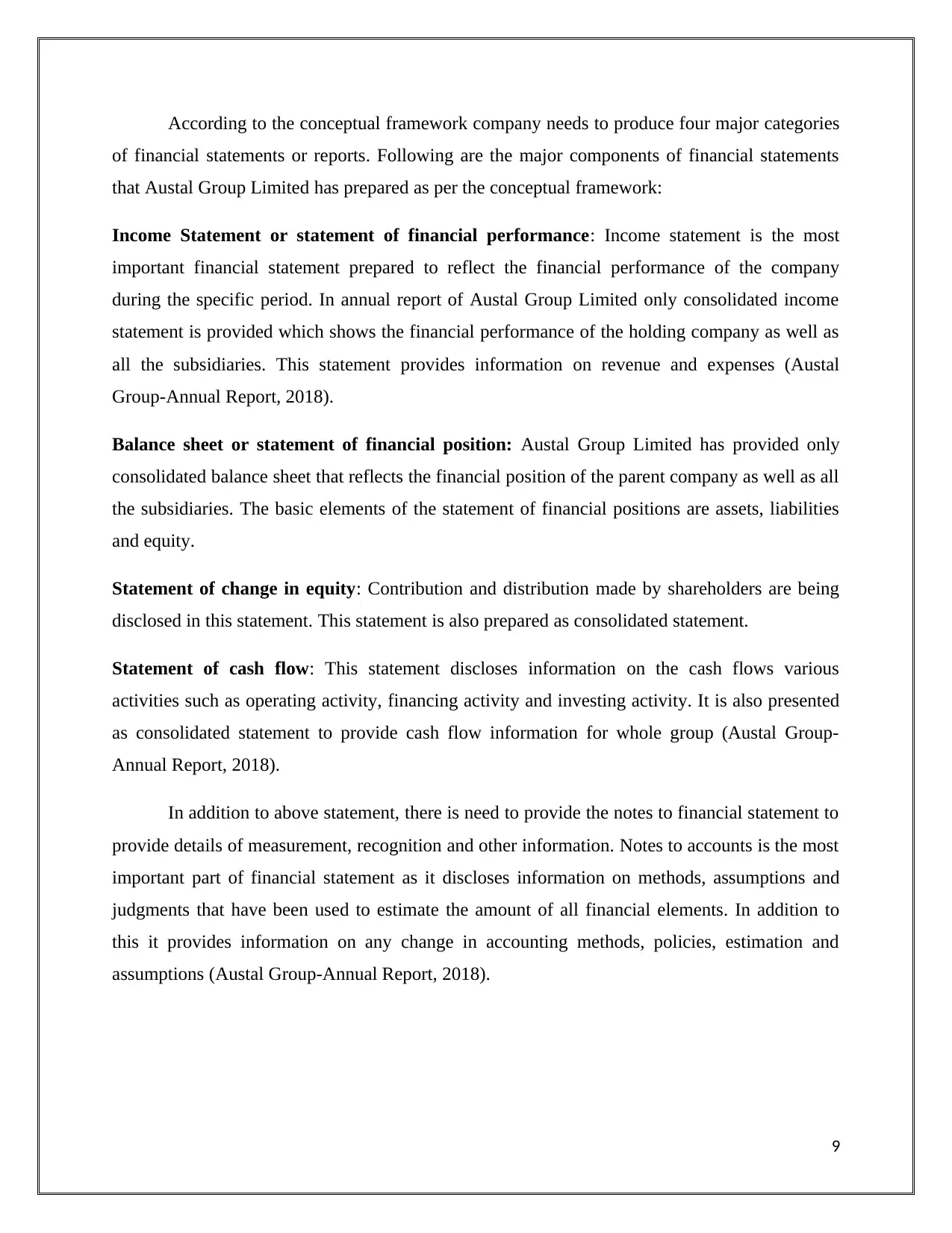
According to the conceptual framework company needs to produce four major categories
of financial statements or reports. Following are the major components of financial statements
that Austal Group Limited has prepared as per the conceptual framework:
Income Statement or statement of financial performance: Income statement is the most
important financial statement prepared to reflect the financial performance of the company
during the specific period. In annual report of Austal Group Limited only consolidated income
statement is provided which shows the financial performance of the holding company as well as
all the subsidiaries. This statement provides information on revenue and expenses (Austal
Group-Annual Report, 2018).
Balance sheet or statement of financial position: Austal Group Limited has provided only
consolidated balance sheet that reflects the financial position of the parent company as well as all
the subsidiaries. The basic elements of the statement of financial positions are assets, liabilities
and equity.
Statement of change in equity: Contribution and distribution made by shareholders are being
disclosed in this statement. This statement is also prepared as consolidated statement.
Statement of cash flow: This statement discloses information on the cash flows various
activities such as operating activity, financing activity and investing activity. It is also presented
as consolidated statement to provide cash flow information for whole group (Austal Group-
Annual Report, 2018).
In addition to above statement, there is need to provide the notes to financial statement to
provide details of measurement, recognition and other information. Notes to accounts is the most
important part of financial statement as it discloses information on methods, assumptions and
judgments that have been used to estimate the amount of all financial elements. In addition to
this it provides information on any change in accounting methods, policies, estimation and
assumptions (Austal Group-Annual Report, 2018).
9
of financial statements or reports. Following are the major components of financial statements
that Austal Group Limited has prepared as per the conceptual framework:
Income Statement or statement of financial performance: Income statement is the most
important financial statement prepared to reflect the financial performance of the company
during the specific period. In annual report of Austal Group Limited only consolidated income
statement is provided which shows the financial performance of the holding company as well as
all the subsidiaries. This statement provides information on revenue and expenses (Austal
Group-Annual Report, 2018).
Balance sheet or statement of financial position: Austal Group Limited has provided only
consolidated balance sheet that reflects the financial position of the parent company as well as all
the subsidiaries. The basic elements of the statement of financial positions are assets, liabilities
and equity.
Statement of change in equity: Contribution and distribution made by shareholders are being
disclosed in this statement. This statement is also prepared as consolidated statement.
Statement of cash flow: This statement discloses information on the cash flows various
activities such as operating activity, financing activity and investing activity. It is also presented
as consolidated statement to provide cash flow information for whole group (Austal Group-
Annual Report, 2018).
In addition to above statement, there is need to provide the notes to financial statement to
provide details of measurement, recognition and other information. Notes to accounts is the most
important part of financial statement as it discloses information on methods, assumptions and
judgments that have been used to estimate the amount of all financial elements. In addition to
this it provides information on any change in accounting methods, policies, estimation and
assumptions (Austal Group-Annual Report, 2018).
9
⊘ This is a preview!⊘
Do you want full access?
Subscribe today to unlock all pages.

Trusted by 1+ million students worldwide
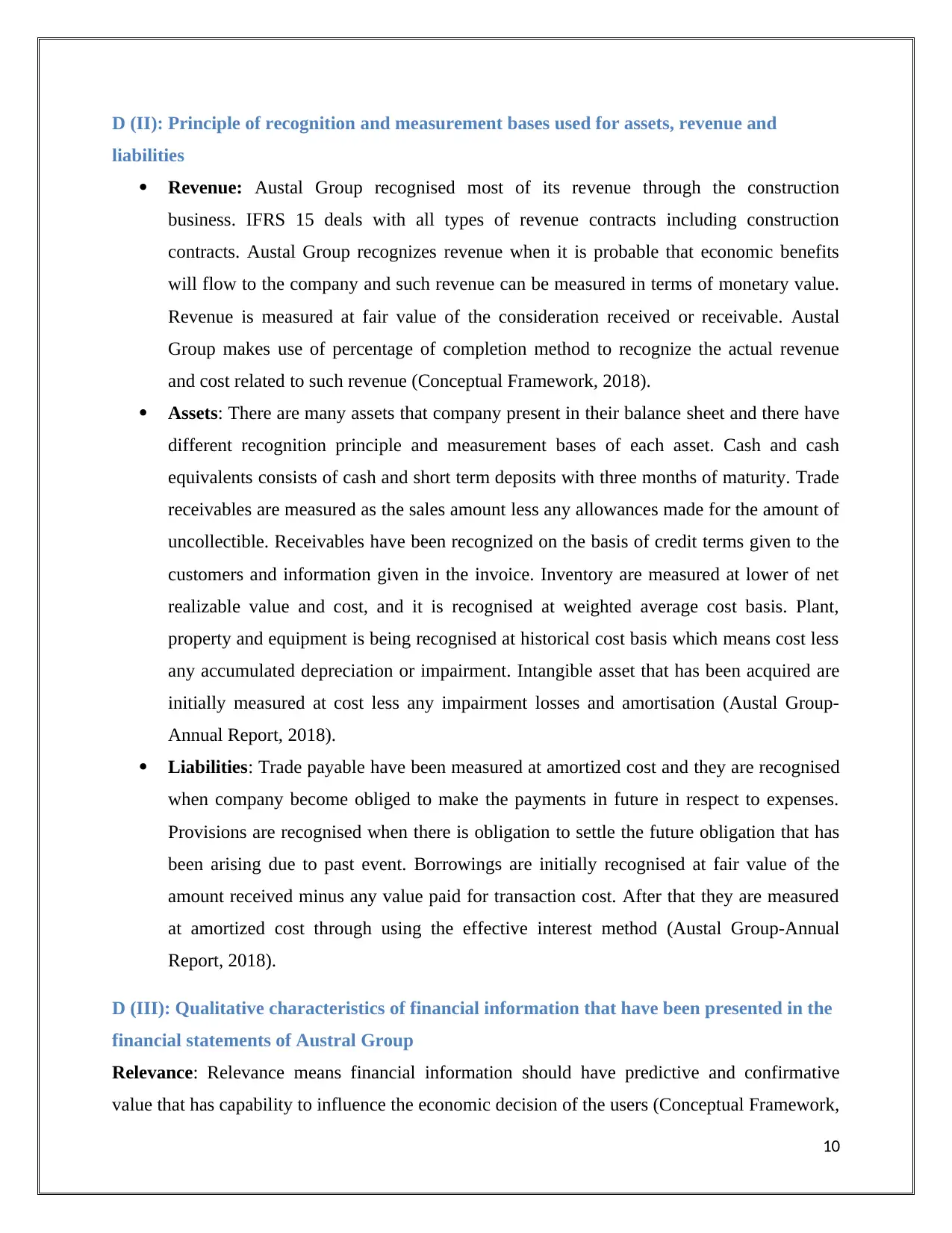
D (II): Principle of recognition and measurement bases used for assets, revenue and
liabilities
Revenue: Austal Group recognised most of its revenue through the construction
business. IFRS 15 deals with all types of revenue contracts including construction
contracts. Austal Group recognizes revenue when it is probable that economic benefits
will flow to the company and such revenue can be measured in terms of monetary value.
Revenue is measured at fair value of the consideration received or receivable. Austal
Group makes use of percentage of completion method to recognize the actual revenue
and cost related to such revenue (Conceptual Framework, 2018).
Assets: There are many assets that company present in their balance sheet and there have
different recognition principle and measurement bases of each asset. Cash and cash
equivalents consists of cash and short term deposits with three months of maturity. Trade
receivables are measured as the sales amount less any allowances made for the amount of
uncollectible. Receivables have been recognized on the basis of credit terms given to the
customers and information given in the invoice. Inventory are measured at lower of net
realizable value and cost, and it is recognised at weighted average cost basis. Plant,
property and equipment is being recognised at historical cost basis which means cost less
any accumulated depreciation or impairment. Intangible asset that has been acquired are
initially measured at cost less any impairment losses and amortisation (Austal Group-
Annual Report, 2018).
Liabilities: Trade payable have been measured at amortized cost and they are recognised
when company become obliged to make the payments in future in respect to expenses.
Provisions are recognised when there is obligation to settle the future obligation that has
been arising due to past event. Borrowings are initially recognised at fair value of the
amount received minus any value paid for transaction cost. After that they are measured
at amortized cost through using the effective interest method (Austal Group-Annual
Report, 2018).
D (III): Qualitative characteristics of financial information that have been presented in the
financial statements of Austral Group
Relevance: Relevance means financial information should have predictive and confirmative
value that has capability to influence the economic decision of the users (Conceptual Framework,
10
liabilities
Revenue: Austal Group recognised most of its revenue through the construction
business. IFRS 15 deals with all types of revenue contracts including construction
contracts. Austal Group recognizes revenue when it is probable that economic benefits
will flow to the company and such revenue can be measured in terms of monetary value.
Revenue is measured at fair value of the consideration received or receivable. Austal
Group makes use of percentage of completion method to recognize the actual revenue
and cost related to such revenue (Conceptual Framework, 2018).
Assets: There are many assets that company present in their balance sheet and there have
different recognition principle and measurement bases of each asset. Cash and cash
equivalents consists of cash and short term deposits with three months of maturity. Trade
receivables are measured as the sales amount less any allowances made for the amount of
uncollectible. Receivables have been recognized on the basis of credit terms given to the
customers and information given in the invoice. Inventory are measured at lower of net
realizable value and cost, and it is recognised at weighted average cost basis. Plant,
property and equipment is being recognised at historical cost basis which means cost less
any accumulated depreciation or impairment. Intangible asset that has been acquired are
initially measured at cost less any impairment losses and amortisation (Austal Group-
Annual Report, 2018).
Liabilities: Trade payable have been measured at amortized cost and they are recognised
when company become obliged to make the payments in future in respect to expenses.
Provisions are recognised when there is obligation to settle the future obligation that has
been arising due to past event. Borrowings are initially recognised at fair value of the
amount received minus any value paid for transaction cost. After that they are measured
at amortized cost through using the effective interest method (Austal Group-Annual
Report, 2018).
D (III): Qualitative characteristics of financial information that have been presented in the
financial statements of Austral Group
Relevance: Relevance means financial information should have predictive and confirmative
value that has capability to influence the economic decision of the users (Conceptual Framework,
10
Paraphrase This Document
Need a fresh take? Get an instant paraphrase of this document with our AI Paraphraser
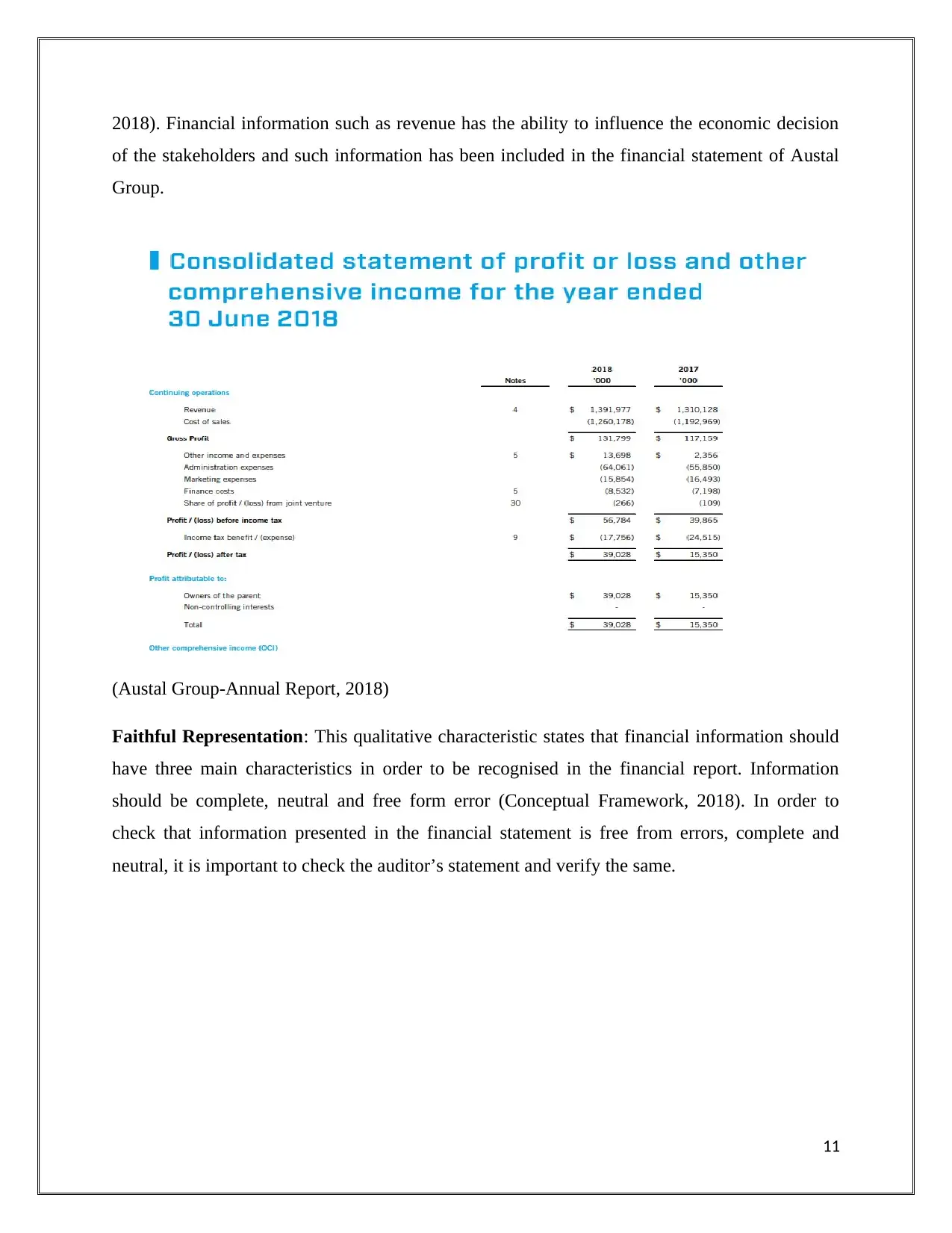
2018). Financial information such as revenue has the ability to influence the economic decision
of the stakeholders and such information has been included in the financial statement of Austal
Group.
(Austal Group-Annual Report, 2018)
Faithful Representation: This qualitative characteristic states that financial information should
have three main characteristics in order to be recognised in the financial report. Information
should be complete, neutral and free form error (Conceptual Framework, 2018). In order to
check that information presented in the financial statement is free from errors, complete and
neutral, it is important to check the auditor’s statement and verify the same.
11
of the stakeholders and such information has been included in the financial statement of Austal
Group.
(Austal Group-Annual Report, 2018)
Faithful Representation: This qualitative characteristic states that financial information should
have three main characteristics in order to be recognised in the financial report. Information
should be complete, neutral and free form error (Conceptual Framework, 2018). In order to
check that information presented in the financial statement is free from errors, complete and
neutral, it is important to check the auditor’s statement and verify the same.
11
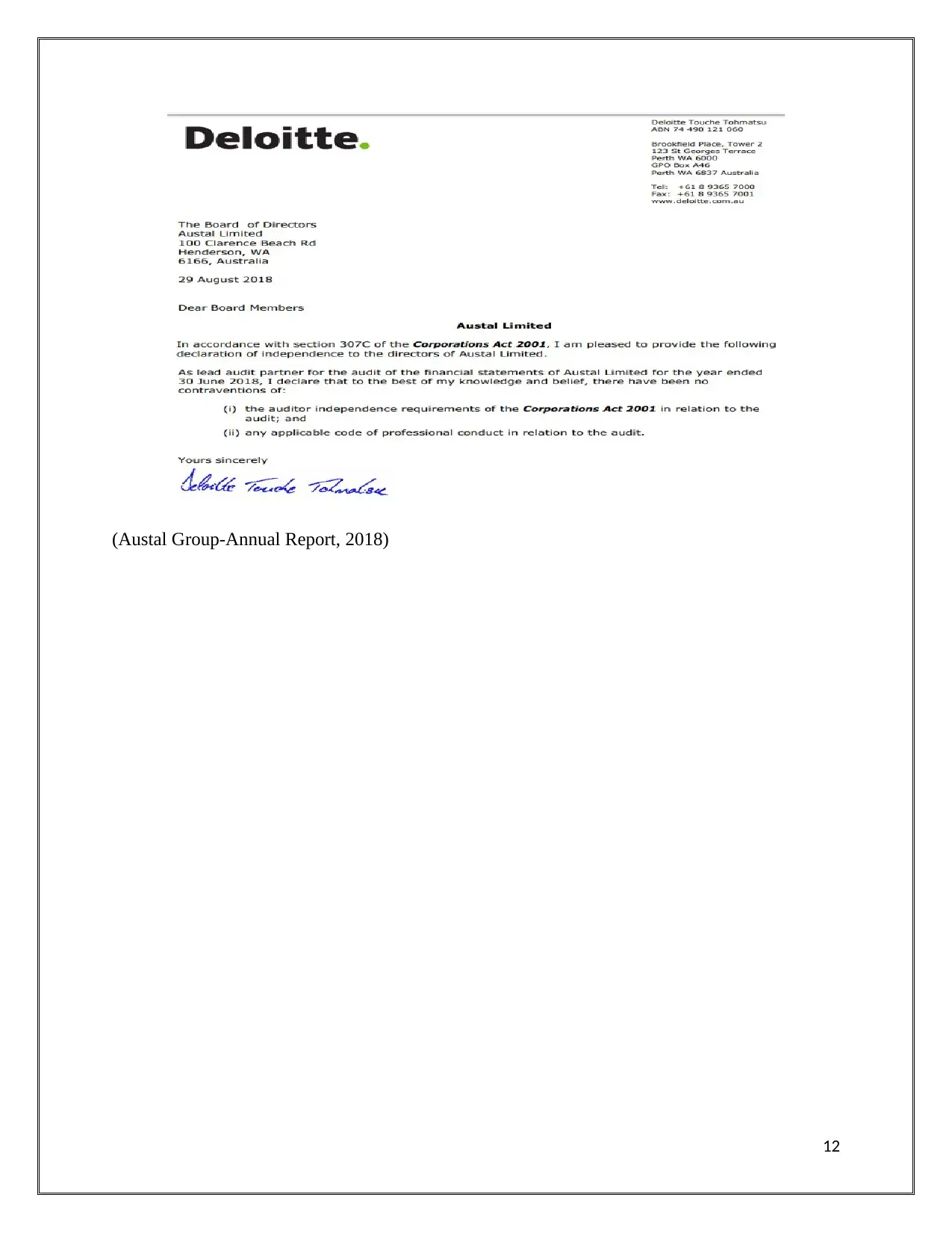
(Austal Group-Annual Report, 2018)
12
12
⊘ This is a preview!⊘
Do you want full access?
Subscribe today to unlock all pages.

Trusted by 1+ million students worldwide
1 out of 22
Related Documents
Your All-in-One AI-Powered Toolkit for Academic Success.
+13062052269
info@desklib.com
Available 24*7 on WhatsApp / Email
![[object Object]](/_next/static/media/star-bottom.7253800d.svg)
Unlock your academic potential
Copyright © 2020–2025 A2Z Services. All Rights Reserved. Developed and managed by ZUCOL.





